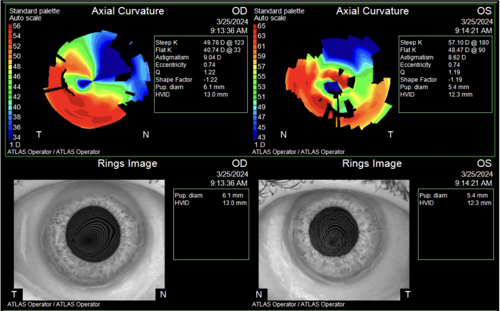Refractive surgeries, such as radial keratotomy (RK) and LASIK, are common procedures aimed at correcting vision. However, these surgeries can sometimes result in complications, including blurred vision and chronic dry eyes, which significantly
affect the patient’s quality of life.
Case Description
This 68-year-old female patient had a history of RK and LASIK surgeries, leading to significant visual impairment and chronic dry eye symptoms. Her occupation involves extensive close work, as do her hobbies of playing several musical instruments, including the piano. She achieved substantial improvement in visual acuity and comfort with the use of scleral lenses, ultimately regaining the ability to perform her professional duties and musical activities.
The patient presented with complaints of blurred and distorted vision, making it impossible for her to perform her professional duties or read music. She also reported chronic dry eye symptoms, with over-the-counter ocular lubricants and prescription dry eye formulations providing little relief.
She underwent RK surgery in both eyes 35 years ago, followed by LASIK surgery many years later. She had been treated with various interventions for dry eyes, with minimal improvement.
Her visual acuity with glasses was OD 20/60, OS 20/70. Refraction was OD +2.75-2.50 x 70, OS +3.50-2.75 x 150. Slit-lamp examination demonstrated significant corneal staining, indicating an unstable ocular surface
Due to the patient’s history of surgically altered and compromised corneal surface, traditional soft lenses were deemed unsuitable as they would exacerbate the dry eye condition. Similarly, GP lenses were not preferred due to the risk of corneal abrasions.
The decision was made to fit the patient with Jupiter scleral lenses (Essilor Custom Contact Lens Specialists) in Optimum Infinite material, which replace the distorted cornea as an optical surface, protect the ocular surface from the environment, and maintain a moist environment for the eye.

Fitting details are as follows: OD 7.34 base curve, -3.00-1.50 x150, 16.6 mm diameter; OS 6.49 base curve, +1.75, 16.6 mm diameter. Both lenses featured a reverse geometry design.
With these scleral lenses, the patient achieved improved visual acuity (20/40) and excellent comfort for the first time in many years. One year later, she underwent cataract surgery in both eyes, requiring refitting with new scleral lenses. The updated lenses provided her with clear (20/20) and comfortable vision.
Discussion
The case highlights the challenges associated with managing post-refractive surgery complications, particularly in patients with dry eyes and distorted corneal surfaces. The use of scleral lenses proved beneficial in this patient by providing a stable optical surface, protecting the ocular surface, and maintaining hydration.
For patients with a history of refractive surgeries and compromised ocular surfaces, scleral lenses offer a promising solution for restoring visual acuity and comfort. In this case, scleral lenses successfully rehabilitated the patient’s vision, allowing her to return to her professional and musical activities with confidence.
____________
Dr. Boshnick operates the Global Vision Rehabilitation Center in Miami, Fl. He is a Fellow of the American Academy of Optometry and the Scleral Lens Education Society. He has no disclosures to report.



